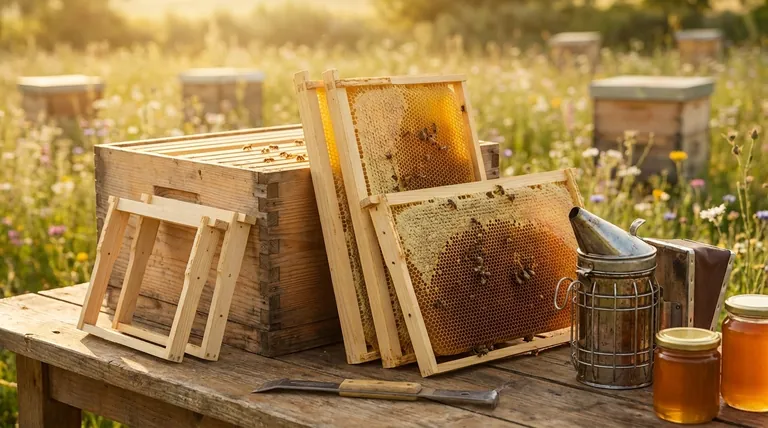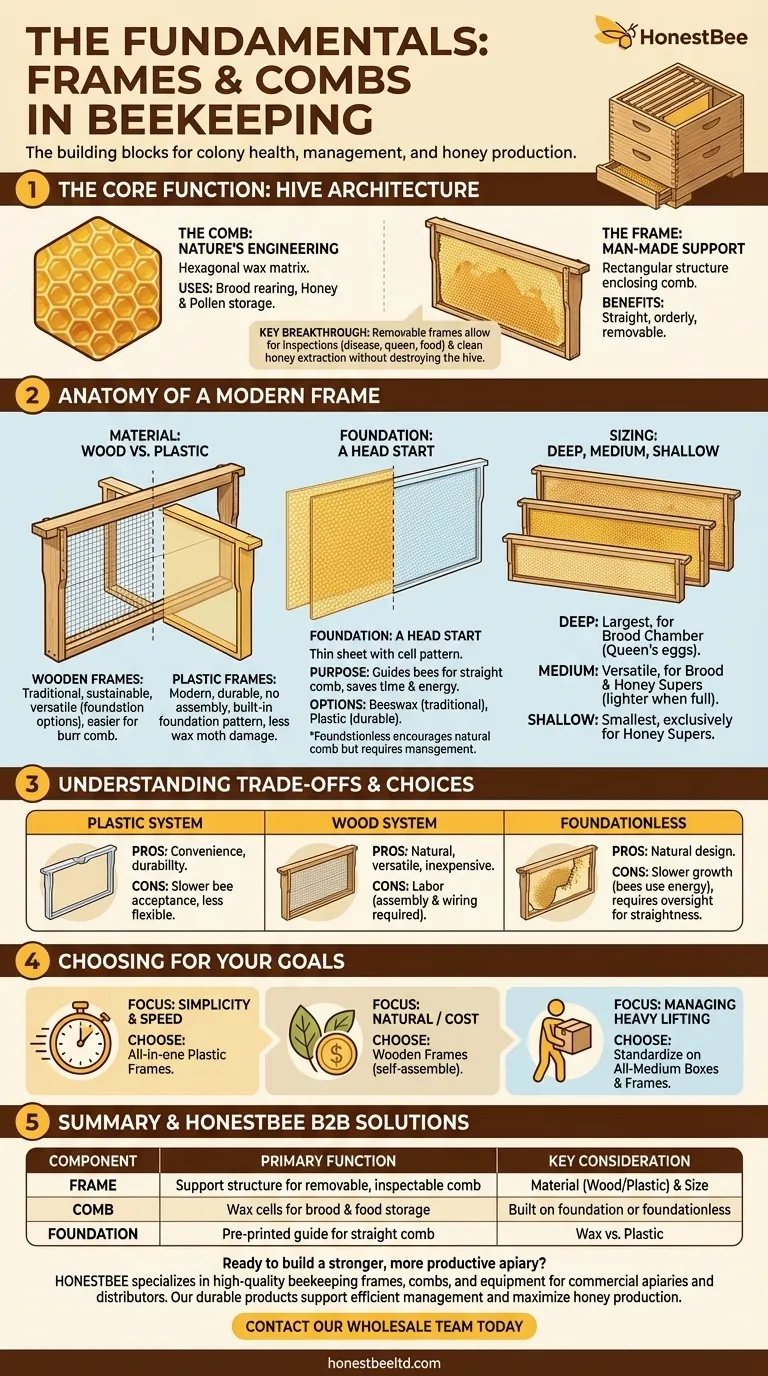In beekeeping, frames and combs are the fundamental building blocks of the hive. Frames are rectangular structures, typically made of wood or plastic, that hold the wax comb. The comb is where the honey bees raise their young (brood) and store all of their food, including honey and pollen.
Frames are more than just a container for comb; they are the central innovation of modern beekeeping. This system provides a removable, inspectable structure that allows beekeepers to manage colony health and harvest honey without destroying the hive.

The Core Function: Structure for the Colony
A beehive is a complex society, and its internal architecture is critical to its survival. Frames and comb provide this essential architecture.
What is a Comb?
A comb is a matrix of hexagonal wax cells built by honey bees. These cells are masterpieces of engineering, used for two primary purposes: raising new bees and storing food.
What is a Frame?
A frame is a man-made support structure that encloses a single sheet of comb. By giving bees a frame to build within, beekeepers ensure the comb is straight, orderly, and, most importantly, removable.
Why This System is a Breakthrough
The ability to remove individual frames allows beekeepers to perform critical inspections for disease, check the queen's egg-laying pattern, and assess food stores. It also enables the clean extraction of honey without damaging the colony's home.
Anatomy of a Modern Frame
While the concept is simple, frames have several components and variations that serve different purposes. Understanding them is key to making good management decisions.
Material: Wood vs. Plastic
Wooden frames are the traditional choice. They are sustainable, can be built from kits or purchased, and offer versatility with different foundation types. They are also easier for bees to attach their own burr comb to.
Plastic frames are a more modern option. They are typically sold as a single, injection-molded piece with the foundation pattern built-in. They are durable, require no assembly, and are less prone to damage from wax moths.
Foundation: A Head Start for Bees
Foundation is a thin sheet of beeswax or plastic imprinted with a hexagonal cell pattern. It is placed inside a frame to give the bees a guide for building straight comb, saving them significant time and energy.
Some beekeepers prefer foundationless frames, which encourage bees to build their own comb from scratch. This is a common practice in "natural" beekeeping but requires more careful management to prevent chaotic cross-combing.
Sizing: Deep, Medium, and Shallow
Frames come in standard sizes that correspond to the boxes (supers) they fit into.
- Deep frames are the largest and are almost always used in the lowest hive boxes for the brood chamber, where the queen lays her eggs.
- Medium frames are the most versatile. They can be used for brood chambers but are most popular for honey supers because they are much lighter than deep frames when full of honey.
- Shallow frames are the smallest and are used exclusively for honey supers.
Understanding the Trade-offs
The choice of frame system is one of the first major decisions a beekeeper makes, and each option comes with distinct advantages and disadvantages.
Plastic: Convenience vs. Bee Acceptance
Plastic frames offer undeniable convenience and durability. However, some beekeepers find that bees are slower to draw out comb on new plastic, and it offers less flexibility than a wooden frame system.
Wood: Sustainability vs. Labor
Wooden frames are the standard for a reason: they are natural, versatile, and relatively inexpensive. Their main drawback is the labor required for assembly, which often includes wiring the frame to support the wax foundation. This wiring is crucial to prevent the comb from sagging or breaking during honey extraction.
Foundationless: Natural Design vs. Slower Growth
Allowing bees to build their own comb is appealing for natural beekeeping. However, it requires significant energy from the bees, resulting in a slower buildup of resources. It also demands vigilant oversight to ensure the bees build straight, manageable combs within the frames.
Choosing the Right Frame System for Your Goals
Your choice of frame will shape your beekeeping experience, from initial setup to the day you harvest honey.
- If your primary focus is simplicity and a fast start: All-in-one plastic frames are the most straightforward and durable option.
- If your primary focus is natural beekeeping or cost: Wooden frames, which you can assemble yourself, provide a sustainable and highly customizable path.
- If your primary focus is managing heavy lifting: Standardizing on all medium-sized boxes and frames for both brood and honey creates an interchangeable system where no single box is excessively heavy.
Understanding these components is the first step toward becoming an effective and confident beekeeper.
Summary Table:
| Component | Primary Function | Key Consideration |
|---|---|---|
| Frame | Support structure for removable, inspectable comb | Material (Wood/Plastic) & Size (Deep/Medium/Shallow) |
| Comb | Hexagonal wax cells for brood rearing & food storage | Built by bees on foundation or foundationless |
| Foundation | Pre-printed guide for straight comb building | Wax (traditional) vs. Plastic (durable) |
Ready to build a stronger, more productive apiary? As HONESTBEE, we specialize in supplying high-quality beekeeping frames, combs, and equipment to commercial apiaries and distributors. Our durable, well-designed products support efficient hive management and maximize honey production. Contact our wholesale team today to discuss your specific needs and discover how our supplies can help your operation thrive.
Visual Guide

Related Products
- Wooden Bee Hive Frames for Beekeeping and Wholesale
- HONESTBEE Professional Long Handled Hive Tool with Precision Cutting Blade
- Copper Bee Frame Eyelets for Beekeeping
- Langstroth Honey Bee Box Hive Boxes for Different Depths
- Professional Galvanized Hive Strap with Secure Locking Buckle for Beekeeping
People Also Ask
- When should bee frames be thrown away? A Beekeeper's Guide to Hive Health & Biosecurity
- What are the standard sizes of frames used in Langstroth hives? Choose the Right Frame for Your Apiary
- What types of beehive frames are compatible with the honey press? A Guide to Crush-and-Strain Extraction
- What is the role of oxalic acid in plants? A Key to Plant Defense and Internal Regulation
- What is the recommended number of frames for a beginner beekeeper? The Essential Rule for a Healthy Hive



















